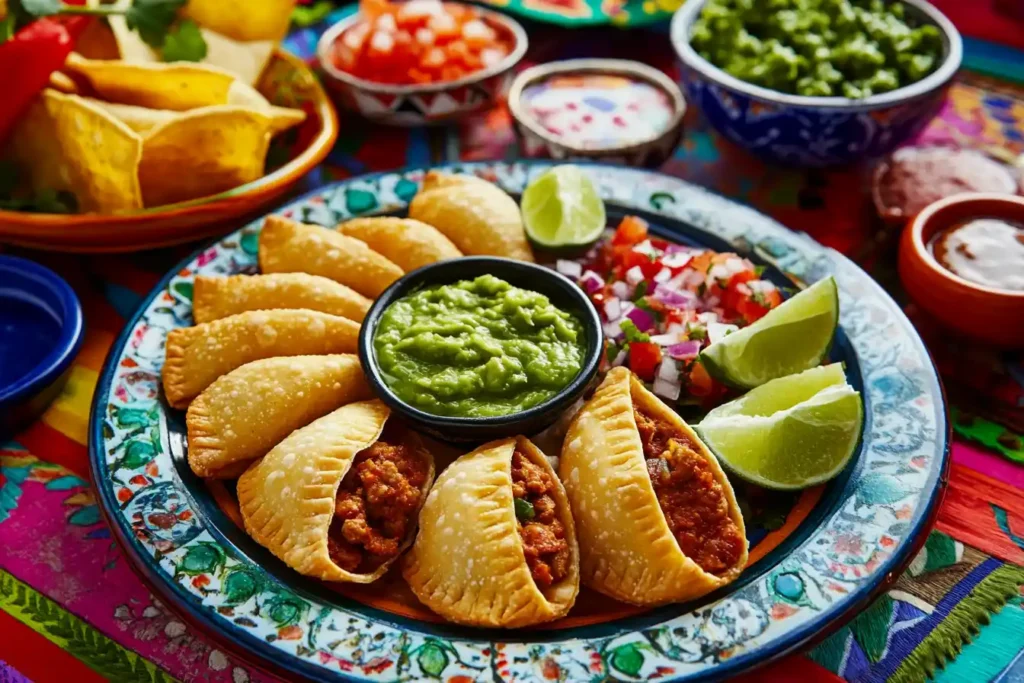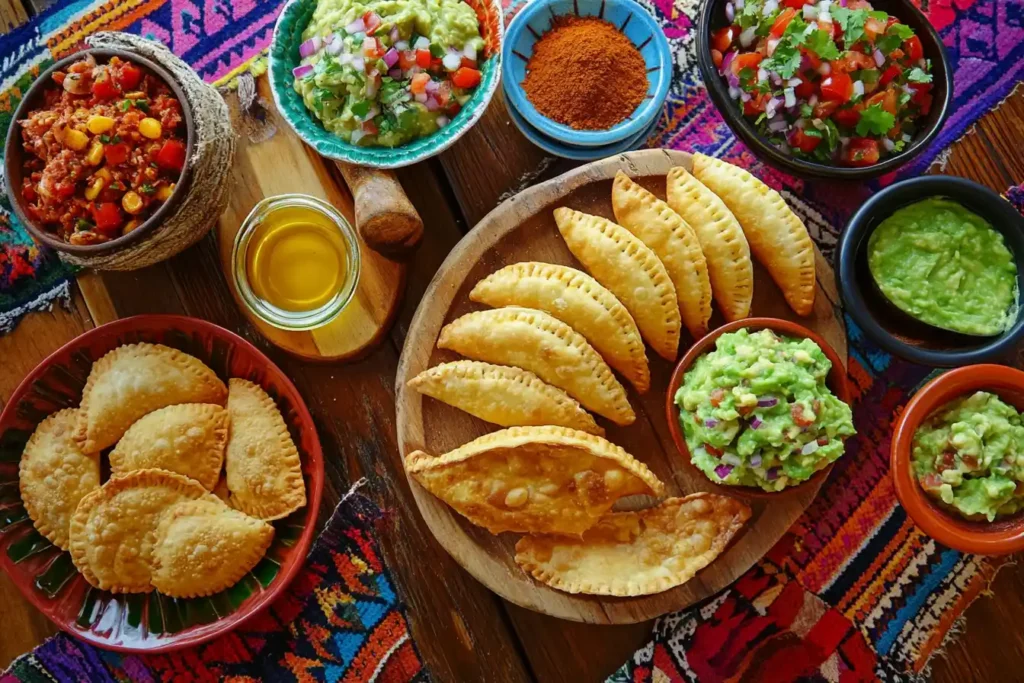Empanadas, a delightful culinary treat, have a special place in kitchens worldwide. These handheld pastries are celebrated for their golden crusts and flavorful fillings. But when it comes to comparing Spanish empanadas with Mexican empanadas, the contrasts are as intriguing as their shared history. In this article, we’ll explore their origins, ingredients, cooking techniques, and cultural nuances, unraveling what makes each version distinct yet universally loved.
Let’s dive into the journey of empanadas, from their Spanish beginnings to their flavorful transformations in Mexico.
Introduction
Overview of Empanadas Globally
Empanadas are more than just food; they’re a symbol of culinary diversity and innovation. Their name comes from the Spanish verb empanar, meaning “to wrap in bread.” Over centuries, they’ve evolved into a beloved dish in many cultures, with every region adding its twist. From savory fillings like spiced meats and cheeses to sweet options bursting with fruits, empanadas cater to a spectrum of tastes.
Globally, people celebrate their versatility as each country infuses them with unique flavors and textures. While some versions emphasize traditional cooking methods, others experiment with contemporary fillings and presentation. Despite these variations, the heart of the empanada remains unchanged: a delightful pocket of dough, filled with love and history.
Focus on Spanish vs. Mexican Empanadas
The question What is the difference between Spanish empanadas and Mexican empanadas? sparks curiosity among food lovers. While they share common roots, their transformation across continents highlights significant contrasts in preparation, presentation, and flavor. Spanish empanadas often lean on simplicity and tradition, while Mexican versions brim with bold spices and regional creativity.
This article will peel back the layers—figuratively and literally—of Spanish and Mexican empanadas. We’ll compare their dough, fillings, cooking methods, and even cultural significance. By the end, you’ll not only know their differences but also appreciate how these two culinary masterpieces reflect their respective cultures.
The Origins of Empanadas
Historical Background of Spanish Empanadas
Empanadas trace their roots back to Spain, with influences from the Moorish occupation. The earliest mentions of empanadas appear in cookbooks from Galicia, where these savory pies were a staple. Traditional Spanish empanadas often used wheat-based pastry dough, filled with local ingredients like tuna, pork, or vegetables. These hearty creations were baked, making them portable and practical for workers.
Spain’s rich cultural history also shaped its empanada varieties. The empanada gallega remains a classic, showcasing Galician flavors like paprika-seasoned seafood. Over time, Spanish empanadas became symbols of regional identity, celebrated in festivals and family gatherings.
The Spread of Empanadas to the Americas
When Spanish colonizers journeyed to the New World, they brought their culinary traditions, including empanadas. These savory pies quickly integrated into Latin American diets, adapting to local ingredients and cooking methods. In Mexico, for instance, the Spanish empanada underwent a significant transformation. Local masa, chilies, and indigenous spices created distinctly Mexican empanadas, often fried and filled with bold, spicy flavors.
This cultural exchange highlights how empanadas evolved from their Spanish roots into the diverse variations we enjoy today.
Mexican Adaptation of Empanadas
In Mexico, empanadas took on a life of their own. Unlike their Spanish counterparts, which prioritize simplicity, Mexican empanadas embrace vibrant fillings and regional diversity. Corn masa, a staple of Mexican cuisine, became a popular alternative to pastry dough, adding a distinct texture and flavor.
Fillings such as chorizo, frijoles, and sweetened fruits reflect Mexico’s culinary boldness. This contrast is a key answer to what is the difference between Spanish empanadas and Mexican empanadas? The evolution of Mexican empanadas showcases the blending of indigenous and colonial influences.
Ingredients Comparison
Dough Composition and Preparation
The dough is where Spanish and Mexican empanadas diverge significantly. Spanish empanadas typically use a wheat-based dough, enriched with olive oil or butter. This dough rolls thin and bakes to create a flaky, golden crust. The simplicity of the dough highlights the filling’s flavors.
On the other hand, Mexican empanadas often use corn masa, especially in rural regions. This masa, made from nixtamalized corn, provides a distinct earthy taste and tender texture. Some Mexican variations do use wheat dough, especially in dessert empanadas, but masa remains a staple.
Fillings in Spanish Empanadas

Spanish empanadas emphasize regional ingredients and balanced flavors. Common fillings include tuna, seasoned with garlic and paprika, or minced pork combined with vegetables like bell peppers. These fillings tend to be savory and straightforward, relying on olive oil and herbs for seasoning. Seafood empanadas are especially iconic, reflecting Spain’s coastal heritage.
Fillings in Mexican Empanadas
In Mexico, the fillings are as diverse as the culture itself. Spicy chorizo, creamy frijoles, and sweet options like pumpkin or guava create a vibrant spectrum of choices. Mexican empanadas often incorporate bold seasonings such as cumin, cinnamon, and chilies, setting them apart from their Spanish cousins. Additionally, regional variations include unique ingredients like huitlacoche (corn fungus) or cajeta (caramelized goat milk).
This dynamic use of fillings underscores what is the difference between Spanish empanadas and Mexican empanadas. Spanish versions highlight simplicity, while Mexican empanadas celebrate bold, layered flavors.
Explore the diversity of empanadas in Latin America with the Empanadas Venezolanas Guide for a broader cultural perspective.
Cooking Techniques
Traditional Spanish Cooking Methods
One of the most distinct features of Spanish empanadas is their cooking method. People almost always bake these empanadas, resulting in a flaky, golden crust. Baking emphasizes the quality of the dough and allows the natural flavors of the filling to shine. Traditional recipes often call for an enriched dough made with olive oil, which pairs beautifully with classic fillings like tuna or seasoned pork.
Cooks typically prepare Spanish empanadas in large sizes and often slice them like a pie. This style reflects their communal nature, making them perfect for family meals or celebrations. The baking method also ensures that the fillings retain their texture and taste without becoming overly greasy.
Mexican Cooking Styles
In contrast, Mexican empanadas are famous for their frying techniques, although baked versions do exist. Frying gives these empanadas a crispy, golden exterior that contrasts beautifully with their soft, flavorful fillings. The use of corn masa dough in some regions creates a rich, earthy crust that’s unique to Mexican cuisine.
Regional preferences also influence how empanadas are cooked. For example, in coastal areas, seafood empanadas might be baked, while in central regions, fried versions with sweet or savory fillings are more common. The versatility of cooking methods highlights how Mexico’s culinary diversity shapes its empanadas.
Cooking techniques play a significant role. Spanish empanadas rely on baking to achieve a flaky texture, while Mexican empanadas often embrace frying for a crispier bite. This contrast showcases how cultural preferences shape preparation methods.
Cultural and Regional Variations
Regional Preferences in Spain
In Spain, empanadas reflect the country’s rich regional diversity. The empanada gallega, originating from Galicia, is one of the most iconic types. It features a large, pie-like structure filled with tuna, onion, and bell peppers, seasoned with olive oil and paprika. This version exemplifies Galicia’s coastal influence and love for seafood.
Other regions add their flair. In Andalusia, empanadas often feature Moorish-inspired spices like saffron, while Catalonia incorporates vegetables like eggplant and zucchini. These regional touches not only highlight local ingredients but also celebrate Spain’s cultural history.
Regional Preferences in Mexico
Mexico’s empanadas vary dramatically depending on the region. In Oaxaca, empanadas de amarillo feature a spicy mole sauce with chicken or cheese, reflecting the area’s love for bold flavors. Meanwhile, in Yucatán, empanadas are filled with cochinita pibil, a slow-roasted pork dish that’s rich in citrus and achiote.
Sweet empanadas are equally beloved, with fillings like pumpkin, guava, or cajeta appearing in festivals and markets nationwide. These variations underscore the creativity of Mexican cuisine and its ability to adapt traditional dishes into something uniquely local.
Celebrating Diversity Through Empanadas
The cultural and regional variations in both Spain and Mexico demonstrate how food transcends borders while retaining its roots. Whether it’s the communal baking of Spanish empanadas or the vibrant frying of Mexican empanadas, each version reflects the people and traditions that created them.
For more delicious recipes, check out our guide to Colombian vs. Venezuelan Empanadas and explore even more regional flavors.
Taste and Texture Differences
Flavors in Spanish Empanadas
Spanish empanadas are celebrated for their subtle, balanced flavors. Their fillings are often simple but flavorful, relying on high-quality ingredients like tuna, pork, or vegetables. Seasonings such as paprika, garlic, and olive oil enhance the natural taste of the fillings without overpowering them. These empanadas have a flaky, tender crust, thanks to the olive oil-enriched dough that’s baked to perfection.
When you bite into a Spanish empanada, the experience is harmonious—the crust melts in your mouth, and the filling offers a savory, comforting flavor. This delicate balance is a hallmark of Spain’s culinary tradition, emphasizing quality over complexity.
Flavors in Mexican Empanadas

Mexican empanadas, on the other hand, are known for their bold and diverse flavors. Fillings like chorizo, spicy beans, or sweet guava burst with vibrant tastes that reflect the country’s love for strong spices and seasonings. Regional ingredients like chilies, cinnamon, and even mole sauce add layers of flavor that are unique to Mexico.
The texture of Mexican empanadas varies depending on whether they’re fried or baked. Fried empanadas have a crisp, golden crust that contrasts beautifully with their soft, flavorful fillings. Corn masa empanadas, in particular, have a slightly gritty texture that adds an earthy depth.
When comparing these two styles, what is the difference between Spanish empanadas and Mexican empanadas? Spanish versions are understated and refined, while Mexican empanadas are bold, lively, and unapologetically flavorful.
Empanadas in Modern Cuisine
Fusion Dishes Inspired by Spanish and Mexican Empanadas
In today’s culinary world, chefs are blending elements of Spanish empanadas and Mexican empanadas to create innovative dishes. For instance, you might find empanadas with traditional Spanish dough but filled with Mexican-style barbacoa or mole. These fusion dishes highlight the versatility of empanadas while introducing new flavor combinations.
Some modern takes include vegan empanadas, gluten-free options, and even dessert empanadas stuffed with exotic fillings like chocolate and chili. These innovations keep the dish exciting and relevant for a global audience.
Empanadas as a Global Trend
Empanadas have transcended their regional roots to become a global food trend. You’ll find them on the menus of fine dining restaurants, street food stalls, and food trucks alike. Their portability and endless variety make them a favorite for busy individuals and adventurous food lovers.
As people continue to ask what is the difference between Spanish empanadas and Mexican empanadas?, the answer becomes part of the global appreciation for these delicious pastries. Whether you prefer the flaky refinement of a Spanish empanada or the bold zest of a Mexican one, it’s clear that empanadas are here to stay.
FAQs Section
Are empanadas from Spain or Mexico?
Empanadas originated in Spain, specifically in the Galicia region, and were later introduced to the Americas by Spanish colonizers. While Spanish empanadas are the original, they’ve been adapted in Mexico and other Latin American countries. Mexican empanadas now have their own distinct identity, shaped by local ingredients and cooking methods.
What are the different types of empanadas?
There are countless types of empanadas, each reflecting the culture of the region they come from. In Spain, empanadas are often large, pie-like creations with simple fillings like tuna or pork. In Mexico, empanadas vary from savory options like chorizo-filled versions to sweet varieties featuring guava or pumpkin. The difference lies in the dough, fillings, and preparation methods.
What makes each country’s empanadas different?
The primary answer to what is the difference between Spanish empanadas and Mexican empanadas? lies in their ingredients and preparation. Spanish empanadas use a flaky, baked dough and simple fillings, while Mexican empanadas often incorporate masa dough, bold spices, and frying techniques.
What country makes the best empanadas?
This is subjective and depends on your taste. Spain offers refined, savory options, while Mexico’s empanadas are vibrant and versatile. Both are delicious in their own ways.
Conclusion
Empanadas are a culinary treasure that highlight the creativity and diversity of Spanish and Mexican cuisines. The differences between them reflect the unique cultural and regional influences of their respective countries. Spanish empanadas focus on simplicity and balance, with baked dough and subtle fillings. In contrast, Mexican empanadas are bold and vibrant, often fried, and filled with a variety of sweet and savory ingredients.
The journey of these savory pastries from Spain to Mexico is a testament to how food evolves and adapts across cultures. Asking what is the difference between Spanish empanadas and Mexican empanadas? not only reveals the culinary contrasts but also celebrates the shared history and love for empanadas worldwide.
No matter which version you prefer, empanadas are a delicious reminder of how food brings people together. Whether you enjoy the flaky crust of a Spanish empanada or the crispy, masa-filled goodness of a Mexican one, there’s no denying their universal appeal. So, the next time you’re craving something hearty and flavorful, why not try both and enjoy the best of both worlds?

